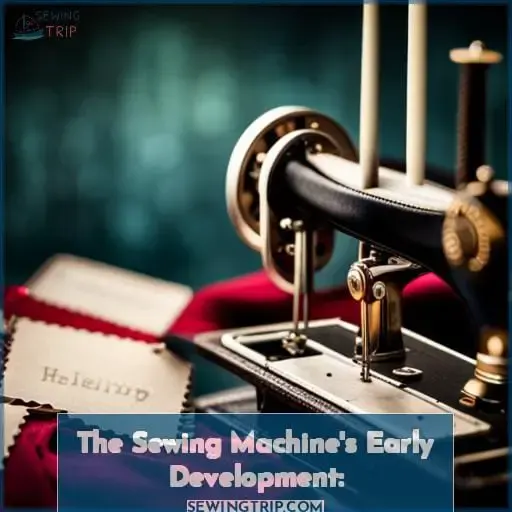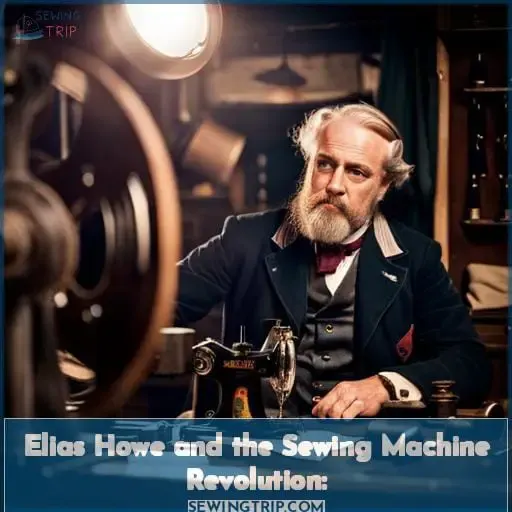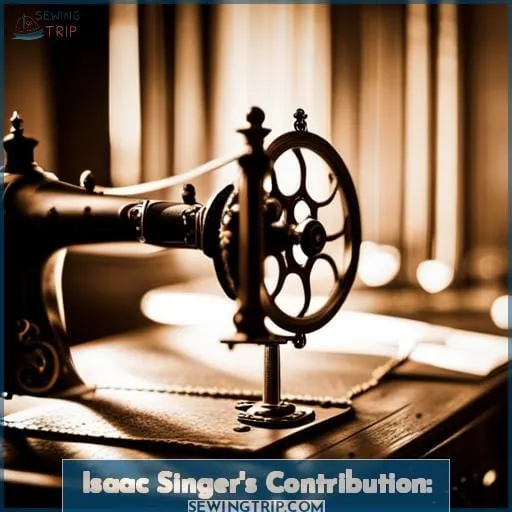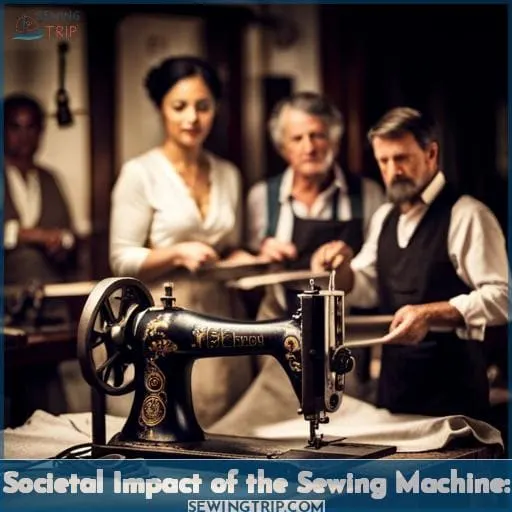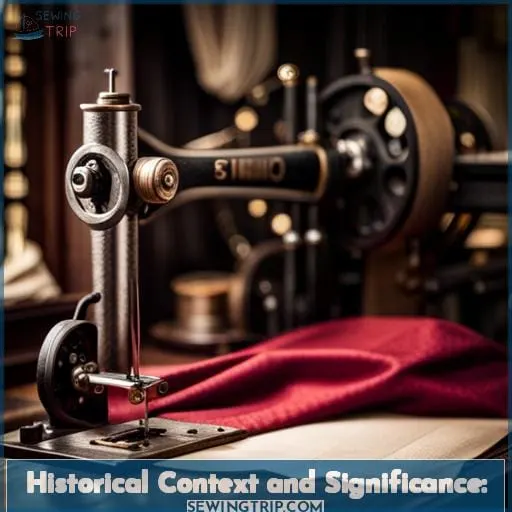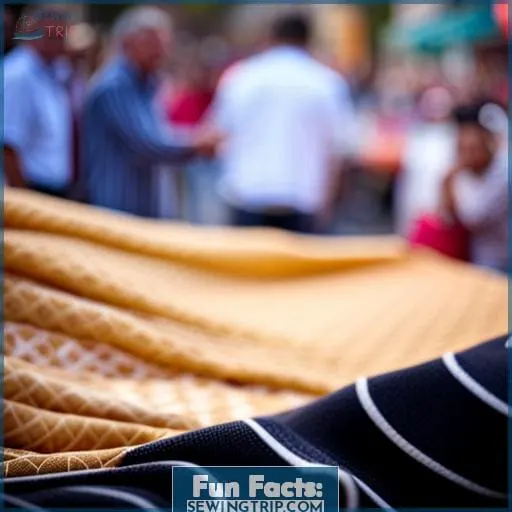This site is supported by our readers. We may earn a commission, at no cost to you, if you purchase through links.
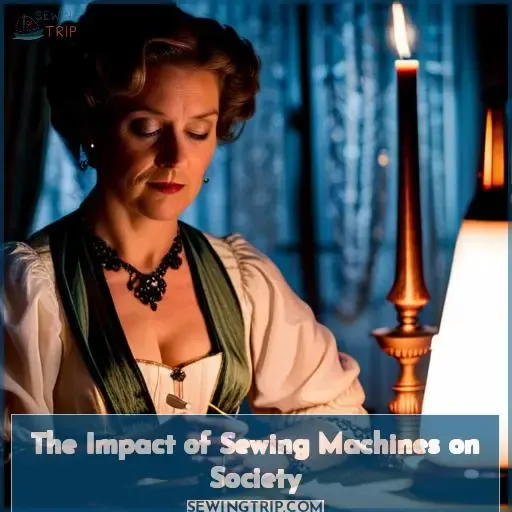 You’re about to learn how humble sewing machines shook the world. These machines freed women from the drudgery of hand-stitching while fueling mass production. As an expert in the evolution of sewing, I’ll guide you through the saga. From early prototypes to legal battles, you’ll see how inventors persevered.
You’re about to learn how humble sewing machines shook the world. These machines freed women from the drudgery of hand-stitching while fueling mass production. As an expert in the evolution of sewing, I’ll guide you through the saga. From early prototypes to legal battles, you’ll see how inventors persevered.
Their machines transformed industries, households, and history. So let’s begin our journey into sewing’s liberation and power.
In the early 19th century, most sewing was done by hand. Women spent hours laboriously stitching clothes for their family. The first sewing machines emerged in the 1830s and 1840s, freeing women from this tedious chore.
Though early models were clumsy and prone to breaking, inventors persistently improved designs. By the 1850s, Isaac Singer created the first commercially successful machine. Though plagued by patent battles, sewing machines grew ubiquitous in middle-class homes by the 1870s.
Industrial sewing machines also revolutionized garment manufacturing. Clothes could now be produced faster and cheaper than ever before. Overall, the sewing machine immensely boosted productivity at home and at work. It spared women hours of daily drudgery, allowing them time for education, social reform, and careers.
The sewing machine also enabled our modern consumer economy, fueling ready-to-wear fashion and mass production.
Table Of Contents
Key Takeaways
- Sewing machines revolutionized garment manufacturing in the 19th century, leading to mass production and higher wages for women.
- The sewing machine played a pivotal role in societal changes, freeing women from tedious work and allowing them time for education, social reform, and careers.
- Sewing machines were vital during wars, such as the Civil War and World War I, for uniform production and stitching aircraft components.
- Sewing machines continue to be relevant in modern times, contributing to personalization and preserving family traditions.
The Sewing Machine’s Early Development:
In 1790, Thomas Saint designed the first sewing machine, and William Newton Wilson later created a prototype based on Saint’s design. However, the French tailor Barthelemy Thimonnier was the first to actually construct a functional sewing machine in 1830.
Regrettably, an angry mob destroyed his workshop out of fear that the sewing machine would cause unemployment.
Thomas Saint’s Design in 1790
The seeds of the sewing revolution were planted in 1790, when Thomas Saint designed an early version of the sewing machine. While the technology at the time couldn’t fully realize Saint’s vision, his innovative concept showed promise.
His pioneering work sparked imaginations and laid the groundwork for later inventors who transformed garment production, unleashing a social revolution. Saint’s forward-thinking design was an important early milestone in the evolution of the sewing machine, though the capabilities of the era limited its potential.
William Newton Wilson’s Prototype
Buddy, you should know that Wilson built the first actual model based on Saint’s idea for an automated sewing machine. He made key improvements to Saint’s plans in the 1790s while working in textile mills.
Wilson’s prototype combined previous innovations and set the stage for sewing to revolutionize the American economy. This early engineering paved the way for mass production of ready-made clothing.
Barthelemy Thimonnier’s French Sewing Machine
Despite the machine’s brilliance, you were horrified when angry tailors smashed Thimonnier’s prototypes, feeling threatened by automation. Thimonnier’s French sewing machine showed promise during the Industrial Revolution, yet its patent in 1830 sparked a backlash.
Still, his innovation left a mark, influencing future inventors even after the destruction of his workshop. Society initially resisted such labor-saving devices, wary of losing jobs, but eventually embraced industrial progress.
Elias Howe and the Sewing Machine Revolution:
Greetings friend, let us explore together the revolutionary impact Elias Howe’s lockstitch sewing machine had on society. In 1846, Howe obtained the patent for the lockstitch sewing machine, featuring a needle with an eye pointed at the end, which along with a shuttle and locking stitch, allowed for substantially increased production speed and efficiency.
Howe overcame numerous patent challenges and his lockstitch mechanism transformed garment manufacturing, enabling mass production, altering labor practices, liberating many women from domestic tedium, and catalyzing lasting changes across society.
Elias Howe’s Motivation and Work Experience
Although born into poverty, Elias Howe persevered with dogged determination to revolutionize the sewing industry. Sensing immense potential, his innate passion for mechanics led him to apprentice as a machinist.
Despite the grueling 80-hour workweeks, Howe gained invaluable skills, envisioning ingenious uses for machines. Witnessing the drudgery of hand sewing ignited his drive to mechanize the process. Fueled by ambition, Howe devoted every spare moment to creating a sewing machine prototype.
His grit in overcoming challenges embodied the entrepreneurial spirit that transforms society.
Patent for the Lockstitch Sewing Machine in 1846
You’ve got to respect how Elias Howe’s 1846 patent for the lockstitch sewing machine revolutionized garment construction with its continuous stitching and ease of use.
- Industry-changing features like the eye-pointed needle and lower thread shuttle allowed for faster and more efficient garment construction.
- The lockstitch mechanism enabled mass production of clothing and removed the tedium from hand sewing.
- Howe persevered through patent challenges to eventually license his game-changing invention to manufacturers like Singer.
Features and Benefits of the Lockstitch Sewing Machine
Unlocking unparalleled utility, Elias Howe’s lockstitch sewing machine brought forth benefits beyond belief, making labor less laborious and liberating countless lives. This remarkable innovation revolutionized the art of stitching with its precise stitches and improved thread tension control.
The feed mechanism ensured smooth fabric movement, while needle technology enhanced sewing efficiency. With these advancements in place, tailors became specialized entrepreneurs, and the impact on society was profound.
Notably, during the Civil War era, when demand soared for uniforms to be produced quickly and efficiently by these incredible machines.
Impact on Production, Labor, and Women’s Employment
When using the lockstitch sewing machine, you’ll witness a transformation in production, labor, and women’s employment that will leave you amazed. The introduction of the sewing machine revolutionized clothing manufacturing by increasing production efficiency and reducing labor time.
Women found new opportunities for employment outside their traditional roles as seamstresses or domestic workers. This shift not only impacted gender roles but also had economic implications by providing higher wages for women and contributing to the rise of the middle class.
Sewing rooms became spaces of empowerment and liberation for women seeking independence through work.
Patent Challenges and Eventual Success
As you delve into Elias Howe’s journey, envision the hurdles he faced in defending his patent and ultimately triumphing over his challengers. The legal battles were fierce, but Howe refused to back down. His success was achieved through perseverance and a deep belief in the value of his invention.
Amidst the chaos of legal challenges, Howe emerged victorious, solidifying himself as a pioneer in sewing machine history. Through it all, he paved the way for future inventors like Allen Wilson to make their mark on this evolving industry.
Lasting Legacy and Impact on Mass Production
| To fully grasp the sewing machine’s lasting legacy, you’ll be amazed by its profound impact on revolutionizing mass production and shaping industries in unimaginable ways. The invention of the sewing machine sparked an industrial revolution in the textile industry, allowing for faster and more efficient production of clothing. With advancements in sewing technology, mass-produced clothing became accessible to a wider audience than ever before. This shift not only transformed the fashion industry but also played a significant role in society’s transition towards modernity and consumerism. | Mass Production Impact | Industrial Revolution |
|---|---|---|
| Textile Industry Influence | Sewing Technology Advancements |
Isaac Singer’s Contribution:
Isaac Singer made a significant contribution to the sewing machine revolution. His marketing strategies and annual production figures propelled the sewing machine into widespread use, including its impact during the Civil War and its application in various industries such as shoemaking.
Marketing Strategies and Annual Production Figures
Isaac Singer’s clever marketing strategies and consistently impressive annual production figures played a pivotal role in propelling the sewing machine into countless homes and businesses, revolutionizing how people worked and lived.
Singer’s marketing prowess extended beyond mere product promotion; he introduced innovative advertising techniques that created a buzz around his machines. His ability to meet historical demand and surpass production milestones allowed him to dominate the competitive landscape, making his name synonymous with sewing excellence.
Impact During the Civil War
During the Civil War, Singer’s innovative machine played a pivotal role, transforming wartime production and supporting the troops. The speed and efficiency of Singer’s sewing machines were harnessed for uniform production, allowing soldiers to be equipped more swiftly.
These machines also aided in producing medical garments such as bandages and hospital gowns. Civilian support for the war effort was enhanced, as the technology enabled a more robust clothing supply, ensuring soldiers were adequately equipped for battle.
Use in Various Industries
In various industries, this versatile machine transformed the way products were made by powering the evolution of manufacturing with its exceptional capabilities. One industry that greatly benefited from sewing machines was shoemaking – an essential part of everyday life at that time.
The introduction of these powerful tools revolutionized footwear production by making it more efficient than ever before while still allowing artisans to maintain a high level of craftsmanship.
Beyond shoemaking, textile innovation flourished with the advent of sewing machines, leading to faster garment creation processes without compromising on quality standards or design intricacies. These innovative advancements enabled manufacturers to produce clothing items quicker than ever before, which allowed fashion trends to spread rapidly throughout society.
In turn, the ability to manufacture large quantities quickly helped meet growing consumer demands.
Moreover, such remarkable machinery played a crucial role even in times marked by warfare. Sewing machines have been extensively used during military operations dating back as far as World War I when they became vital components in uniform factories.
As conflicts progressed into larger scales, so did their uses. Military personnel depended upon uniforms produced through mass-production techniques. The versatility offered extended further, catering not only to uniforms but also aiding parachute assembly, thereby ensuring safety measures were effectively integrated within aerial missions.
Furthermore, in less obvious ways, agriculture stood tall amongst other sectors benefiting immensely due to precision stitch work carried out utilizing such marvels. Numerous agricultural endeavors involved the utilization and storage of bulk materials, often in the form of sacks, which were stitched together with sewing machines.
As a result, the efficiency and durability associated with these sacks ensured that perishable goods like grains and vegetables could sustain transportation without any spoilage.
Lastly, in an era where aviation was still in its infancy, it is fascinating to discover how instrumental sewing machines turned out to be for this industry. Particularly during the manufacturing process, these devices played an integral role by stitching together fabrics, creating durable structures such as wings, fuselages, or even interior upholstery.
Their reliability proved indispensable, allowing aircraft to soar higher while ensuring safety measures were adhered to.
Societal Impact of the Sewing Machine:
The sewing machine had a profound impact on society, bringing about significant changes in various aspects. It facilitated the transition from self-sufficient households to specialized production, liberating women from tedious sewing tasks and opening up new opportunities for them.
Additionally, it played a crucial role in shaping advertising strategies and societal norms while contributing to the emergence of industrial capitalism.
Transition From Self-sufficient Households
Imagine a time when households were self-sufficient, with every member responsible for their own clothing and textiles. The introduction of the sewing machine brought about a domestic revolution, transforming the way people produced garments.
- Independence: Sewing machines allowed individuals to create their own clothes quickly and efficiently.
- Domestic Revolution: The sewing machine shifted textile production from homes to factories, leading to specialization and increased productivity.
- Economic Shift: With mass production made possible by sewing machines, industries boomed, creating new economic opportunities.
- Gender Roles: Women could now pursue other professions as they no longer had to spend hours hand-sewing garments at home.
- Technological Advancement: The invention of the sewing machine marked a significant milestone in technological progress.
The impact of the transition from self-sufficient households cannot be overstated. It not only liberated women but also paved the way for industrial capitalism by streamlining garment production. This advancement in technology forever changed our relationship with clothing and set us on a path towards greater independence and mastery over our lives.
Liberation of Women From Tedious Sewing
Experience the freedom and joy that comes from being liberated from hours of monotonous needlework, allowing you to pursue your passions and dreams. The sewing machine revolution brought about a significant change in women’s lives, marking a milestone in gender equality.
No longer confined to endless stitching by hand, women were empowered to explore new opportunities beyond household chores. With their newfound time and energy, they became active participants in society, contributing to the workforce and making strides towards their own independence.
Stitching freedom was not just about fabric; it was about breaking barriers and shaping history.
Impact on Advertising and Societal Changes
Unleash the power of advertising and witness society’s transformation as the sewing machine weaves its way into every aspect of everyday life. With clever marketing strategies, manufacturers capitalized on the newfound efficiency and convenience offered by these machines, targeting women as their primary consumers.
As a result, gender roles began to shift, with women empowered to pursue other interests beyond endless hours spent on needlework. The cultural landscape evolved alongside this technological advancement, paving the way for a new era of liberation and opportunity.
Role in the Emergence of Industrial Capitalism
Step into the 19th century and witness how the sewing machine played a pivotal role in propelling forward industrial capitalism, forever transforming the landscape of production and commerce. With its ability to mechanize stitching, it revolutionized labor-intensive tasks previously done by hand.
By increasing productivity and reducing costs, manufacturers could now produce clothing on a larger scale, catering to growing consumer demands. This shift not only accelerated economic growth but also ushered in an era where machines became integral to capitalist systems worldwide.
Historical Context and Significance:
To truly understand the historical context and significance of the sewing machine, it is crucial to examine its place within the broader landscape of 19th-century inventions. From early attempts by various inventors to connections with intellectual property and lawsuits, this examination reveals how the sewing machine’s impact extends far beyond its initial introduction.
Moreover, even in modern times, this invention continues to hold relevance as a testament to human ingenuity in revolutionizing clothing production and design.
Broader Context of 19th-century Inventions
In the midst of a whirlwind century filled with inventive sparks that ignited progress like flint and steel, the sewing machine emerged as a transformative force, stitching together a tapestry of change in its wake.
Impact on Industrialization:
The sewing machine accelerated the industrial revolution by automating a labor-intensive process, revolutionizing textile production, and facilitating the growth of the garment industry.
Technological Advancements:
Innovations in sewing machine design mirrored the era’s technological progress. They ranged from hand-cranked machines to motorized models, showcasing the relentless pursuit of efficiency.
Patent Disputes:
The sewing machine’s history is marred with patent disputes, exemplifying the fierce competition among inventors and businesses seeking to control this revolutionary technology.
Economic Transformation:
This invention redefined work, offering employment to women in factories and transforming household economics by saving time once dedicated to sewing, underpinning a new economic landscape.
Early Attempts at Sewing Machines by Various Inventors
Explore the inventive landscape of the early 19th century, where a multitude of visionaries such as Thomas Saint, William Newton Wilson, and Barthelemy Thimonnier were striving to create a revolutionary machine.
These inventor pioneers tinkered with early innovations and sewing prototypes, each contributing their unique ideas to the development of historical sewing machines. Their efforts laid the foundation for the transformative sewing machines that would later change the course of history and revolutionize the textile industry.
Connections to Intellectual Property and Lawsuits
Dive into the delicate dance of intellectual property and lawsuits as inventors fiercely fought for recognition and control over their sewing machine designs. The early days witnessed intense competition among various individuals vying to claim credit for revolutionizing garment production through mechanization.
Inventor Barthelemy Thimonnier’s French patent set off a wave of backlash from fellow innovators who believed they deserved rightful acknowledgment for similar inventions. The resultant litigation shed light on complex issues surrounding intellectual property and laid foundations for future legal battles within the sewing machine world.
These intricate lawsuits highlight both innovation and the rapidly evolving nature of the garment industry.
Continued Relevance in Modern Times
Discover how the sewing machine has maintained its relevance in modern times, continuing to revolutionize industries and empower individuals with its efficiency and versatility. Sewing innovations have embraced sustainable fashion, allowing eco-conscious consumers to create their own clothing using upcycled materials.
The rise of DIY culture has fueled a renewed interest in sewing as a creative outlet and means of self-expression. Advancements in sewing technology have made it easier than ever for beginners to learn, while textile trends constantly inspire new designs and techniques.
The sewing machine remains an essential tool for those seeking liberation through mastery of their craft.
Fun Facts:
Let’s explore some fascinating fun facts about the sewing machine and its impact on society. Did you know that the Wright Brothers, pioneers of aviation, used Singer sewing machines in their workshop? Not only that, but Singer’s affordable machines also revolutionized personalization by allowing individuals to create their own unique garments.
These fun facts highlight the enduring personal connection people have with sewing machines and how they continue to shape our lives today.
Use by the Wright Brothers
Immerse yourself in the fascinating world of the Wright Brothers, pioneers of flight, who relied on Singer sewing machines to bring their innovative aircraft designs to life.
- Precision Stitching: The Wright Brothers used Singer machines for intricate stitching on their fabric-covered wings.
- Aerial Seamstress: Their sister Katharine played a crucial role as an expert seamstress, ensuring strong and durable seams.
- Lightweight Construction: Sewing allowed them to create lightweight structures that could withstand the rigors of flight.
- Experimental Modifications: They frequently modified their planes with new features using needle and thread before testing them in flight.
- Legacy Continues: Even today, aerial enthusiasts appreciate the importance of proper sewing techniques in aircraft construction.
The connection between aviation and sewing highlights how these seemingly unrelated fields can come together to achieve remarkable innovations like powered human flight by humans.
Affordability and Impact on Personalization
Explore how Isaac Singer’s affordable and customizable sewing machine revolutionized the way individuals expressed their personal style, as well as empowered them to create unique garments tailored to their own preferences.
With an array of customization options and versatile sewing techniques at their fingertips, people could now experiment with personalized fashion like never before. From intricate embroidery and decorative stitching to precise tailoring trends, Singer’s machine allowed for creative embellishments that elevated clothing from mere necessity to a statement of individuality.
The possibilities were endless, giving people a newfound sense of liberation and mastery over their personal style choices.
Enduring Personal Connection in Households
You might be surprised to learn that even in modern homes, over 50% of households still maintain a special connection with sewing machines, often using them for creative projects and repairs. Sewing machines have become the centerpieces of family traditions, carrying sentimental attachments from one generation to the next.
They are not just tools but vessels of shared memories and knowledge. Sewing workshops and the thriving DIY culture continue to strengthen this enduring personal connection, fostering a sense of liberation, power, and mastery in the art of sewing.
Conclusion
It’s clear that sewing has had a significant impact on society, from its early development to its modern relevance. Thomas Saint, William Newton Wilson, Barthelemy Thimonnier, Elias Howe, and Isaac Singer all had a hand in revolutionizing the way we sew, with Singer’s machine being used in various industries and by the Wright Brothers.
Sewing machines have enabled us to transition from self-sufficient households to specialized production, liberating women from tedious work and allowing them to enter the workforce. They have also had a profound impact on advertising and the emergence of industrial capitalism.
Finally, the affordability and personalization of Singer sewing machines have established an enduring connection with households throughout the ages.

